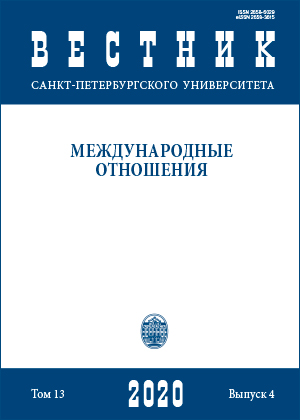Brzezinski and Mackinder theories: Role and influence on the political construction of Eurasia
DOI:
https://doi.org/10.21638/spbu06.2020.407Аннотация
International relations theories act as the guiding lantern to provide a simple yet powerful description of international phenomena such as war, expansionism, alliances and cooperation. Thus, the primary objective of this article is to analyze international relations theories, their roles and influence on global politics hereby bridging the gap between the abstract world of theory and the real world of policy. The article utilizes the Grand Chess Board and Heartland theories on the regional geopolitical processes in Eurasia. The core argument of the article is that theoretical perception creates regional identities, and states use these emerged identities to influence geopolitical traditions. The Grand Chess Board theory of Brzezinski states that in order to sustain its position as a global hegemon, the US needs to control and manage Eurasia. Moreover, this article analyses American foreign policy in Eurasia under the umbrella of the Grand Chess Board theory. The Chinese strategy towards Eurasia through the prism of Mackinder’s Heartland theory is also explored. By analyzing initiatives such as One Belt One Road (OBOR), the Shanghai Cooperation Organization and the energy push in Central Asia, this article can serve as an examination into the Chinese taking up the mantle of the heartland to emerge as the land power of the 21st century
Ключевые слова:
geopolitics, foreign policy, international relations theory, China, Central Asia, Eurasia, USA
Скачивания
Библиографические ссылки
Bassin, M. (1987), Imperialism and the nation state in Friedrich Ratzel’s political geography, Progress in Human Geography, vol. 11, iss. 4, pp. 437–495.
Kristof, K.D. (1960), The Origin and Evolution of Geopolitics, The Journal of Conflict Resolution, vol. 4, iss. 1, pp. 15–51.
Kullberg, A.K. (2000), The Return of Heartland, Eurasian Politician, iss. 1, pp. 1–25.
Kelly, P. (2019), Rescuing Classical Geopolitics, Geopolitics, History and International Relations, vol. 11 (1), pp. 41–58. Вестник СПбГУ. Международные отношения. 2020. Т. 13. Вып. 4 535
Sloan, G. (2017), Geopolitics, Geography and Strategic History. New York and London: Routledge.
Sharshenova, A. (2009), Political construction of geography: US and Russian concept of Central Asia, POLIS Journal, iss. 2. Available at: http://www.polis.leeds.ac.uk/assets/files/students/student-journal/mawinter-09/aijan-sharshenova-winter-09.pdf (accessed: 11.12.2013).
Chapman, B. (2018), Sloan on Geopolitics, Geography and Strategic History in Geopolitics, Geopolitics, History and International Relations, vol. 10 (2), pp. 7–16.
Labban, M. (2009), The Struggle for the Heartland: Hybrid Geopolitics in the Trans-Caspian, Geopolitics, vol. 14, iss. 1, pp. 1–25.
Sprinz, D.F. and Nahmias, Y.W. (2004), Models, Numbers and Cases: Methods for studying International Relations. Ann Arbor: The University of Michigan Press.
Mackinder, H.J. (1904), The Geographical Pivot of History, The Geographical Journal, vol. 23, iss. 4, pp. 421–437.
Scott, M. and Alcenat, W. (2008), Revisiting the Pivot: The Influence of Heartland Theory in the Great Power Politics. Available at: https://www.creighton.edu/fileadmin/user/CCAS/departments/PoliticalScience/MVJ/docs/The_Pivot_-_Alcenat_and_Scott.pdf (accessed: 15.06.2019).
Matikeeva, S. (2005), Mackinder’s Legacy: Was it a Prophesy? Central Asia and the Caucasus, vol. 36, iss. 4, pp. 24–28.
Hagan, K. (2006), Global Geostrategy: Mackinder and the Defense of the West, Journal of Military History, vol. 10, iss. 2, pp. 521–523.
Report of National Security Strategy of United States (1988). Available at: http://nssarchive.us/ NSSR/1988.pdf (accessed: 18.05.2019).
Iseri, E. (2009), The US Grand Strategy and the Eurasian Heartland in the Twenty-First Century, Geopolitics, vol. 14, iss. 1, pp. 26–46.
Jiali, M. (1999), Central Asia: Geostrategic and Big Power Policies, Contemporary Central Asia, vol. 3, iss. 1, pp. 39–46.
Haass, R. (2003), Why Washington welcomes China’s rise, South China Morning Post. Available at: https://carnegieendowment.org/pdf/files/pg2.pdf (accessed: 29.05.2019).
Sutter, R. (2003), China Remains Wary of the U.S. Led World Order, Yale Global Online. Available at: https://yaleglobal.yale.edu/content/china-remains-wary-us-led-world-order (accessed: 12.03.2019).
Shanghai Cooperation Organization (2018), Information Report following the meeting of the Council of Head of State of the Shanghai Cooperation Organization Member States. Available at: http://eng.sectsco. org/news/20180610/443710.html (accessed: 15.06.2019).
Harper, T. (2017), Towards an Asian Eurasia: Mackinder’s Heartland Theory and the return of China to Eurasia, Cambridge Journal of Eurasian Studies, iss. 1, pp. 1–27.
Abilov, S. (2012), The “New Great Game” Over the Caspian Region: Russia, the USA, and China in the Same Melting Po, Khazar Journal of Humanities and Social Sciences, vol. 15, iss. 2, pp. 29–59.
Sarker, N.I. et al. (2018), One Belt One Road Initiatives of China: Implications for Future of Global Development, Modern Economy, vol. 9, no. 4, pp. 623–638.
Brzezinski, Z. (1997), The Grand Chessboard. New York: Basic Books Publishers.
Patnaik, A. (2016), Central Asia: Geopolitics security and stability. London and New York: Routledge
Загрузки
Опубликован
Как цитировать
Выпуск
Раздел
Лицензия
Статьи журнала «Вестник Санкт-Петербургского университета. Международные отношения» находятся в открытом доступе и распространяются в соответствии с условиями Лицензионного Договора с Санкт-Петербургским государственным университетом, который бесплатно предоставляет авторам неограниченное распространение и самостоятельное архивирование.




